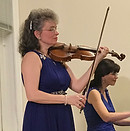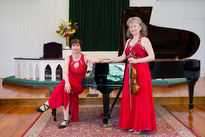
Szlubowska - Belsky Duo
Marta Szlubowska, violin and Svetlana Belsky, piano
Critically acclaimed and internationally renowned in their individual careers, violinist Marta Szlubowska and pianist Svetlana Belsky unite to explore the great masterpieces of violin and piano repertoire, as well as lesser-known works of Polish and Ukrainian composers.


BIOGRAPHIES
Praised for her “warm lyricism and flawless technique” by Le soir (Belgium) and for her “gripping performance of music by Grazyna Bacewicz” by The Washington Post, Polish violinist, Marta Szlubowska is a sought-after soloist, chamber musician, teacher and a concertmaster. Her concerts have taken her to over 15 countries throughout Europe and Americas. Since 2004 she has been the Concertmaster and Soloist of the Mississippi Symphony Orchestra in Jackson, MS.
A winner of numerous awards, fellowships and prizes such as 1st Prizes at the Marbury and Yale Gordon Competitions and the 2nd Prize in the Bryan International String Competition, Ms. Szlubowska has appeared as a soloist with the Rochester Philharmonic, North Carolina Symphony, and many others. She has given numerous performances at Tanglewood, Meadowmount and Colorado Music Festivals. Ms. Szlubowska performed under the baton of Leonard Bernstein and Seiji Ozawa at Tanglewood, as well as Alexander Schneider at Carnegie Hall and the Kennedy Center for the Performing Arts.
Her passion for solo and chamber music led Ms. Szlubowska to work with various ensembles such as Mississippi Fine Arts String Trio, Mississippi Orchestra String Quartet, Inaugural Piano Trio, Tango Rendezvous Ensemble, as well as Marta Szlubowska Ensemble, a vibrant and exciting strings and accordion ensemble that showcases light classical and popular music from around the world. The ensemble has performed at St. Paul Concert Series in Meridian, Arts and Lecture Series at Millsaps College, and many more.
Ms. Szlubowska holds Bachelor’s and Artist Diploma degrees from the Peabody Institute of the Johns Hopkins University and Master’s Degree in Violin Performance from the University of Massachusetts at Amherst. Her teachers include Janusz Szok, Charles Libove, Berl Senofsky and Charles Treger.
Marta Szlubowska
Critically acclaimed as "a passionate pianist and scholar," Svetlana Belsky is an in-demand recitalist and chamber pianist, noted for her remarkable rapport with audiences and stylistic versatility. She has appeared in Italy, Ukraine, Russia, Poland, China, Taiwan and Hong Kong, and throughout the United States. Dr. Belsky has received awards both for her performances in international piano competitions, and for her advocacy of new American music.
Her recordings have been heard on radio stations worldwide. The American Record Guide hails her CD of the solo version of Stravinsky’s Rite of Spring (Centaur, 2014) as an “extraordinary performance.” The album is the recipient of a Global Music Award.
While Svetlana’s musical interests range from performing early Baroque masterpieces on harpsichord to premiering new music commissioned by her chamber ensembles, the love of her musical life is the music and the legacy of Ferruccio Busoni. She is the author of Busoni as Pianist (am annotated translation from the Russian, Eastman Studies in Music, 2010), which had been featured on BBC radio in December 2016. Her most recent CD Busoni: The Late Works (Ravello, 2019) is described as "Marrying awe-inducing technical capabilities to an artistic intuition of mind-boggling depth.”
Following emigration from the Soviet Union, Dr. Belsky studied with Emilio Del Rosario in Chicago. She earned her Bachelor of Music summa cum laude and Master's degrees from the Peabody Conservatory of Music, studying with Ann Schein. Later, she earned her Doctorate in Performance at the Manhattan School of Music, working with Nina Svetlanova. As the Coordinator of Piano Studies at the University of Chicago, Dr. Belsky has taught students from four continents, among many other academic responsibilities. Currently she is the Artistic Director of Sheridan Music Studio.
Svetlana Belsky

CRITICS SAY
"Stunningly beautiful"; Szymanowski's "Dryads and Pan" is "wonderfully fantastical... Marta Szlubowska's virtuosity really takes off and Belsky has the most delicious of light touches." Paderewski violin sonata "exudes a Brahmsian warmth, especially when heard with Szlubowska's generosity of tone, while Belsky plays the demanding piano part with elfin fingers, skittering up and down the keyboard. Communication between the two players is a joy. [The middle movement] includes moments of intense beauty; the way the players here can melt into sweet lyricism is intensely memorable. Hats off to Szlubowska and Belsky for giving such a concentrated, successful reading"
-Colin Clarke, Fanfare Magazine
"The performance (of Paderewski's Violin Sonata) is full of vigor and vitality. The violin is bright and warm and the piano, fluid and flowing. There is beautiful interplay between the two musicians and nuanced details. The disc also features Mythes by Karol Szymanowski. Here the performers draw out the poetry and exoticism of the score."
-M. L. Rantala, Hyde Park Herald
"Myth and Romance begins with the three-movement “Mythes, Op. 30” by Karol Szymanowski. All three are virtuosic works that allow both artists to demonstrate their mastery of their instruments. Composed when Paderewski was 22, the Sonata is my favorite work on the album. The first movement, “Allegro con fantasia,” is beautifully lyrical and played with heartfelt emotion by both artists. The second movement, “Intermezzo. Andantino,” is expressed with tenderness and grace. The Finale, “Allegro molto quasi presto,” is a real showpiece with passages that are bold and dramatic and others that are much quieter and more subtle - a great way to end this excellent album! Brava to both Marta Szlubowska and Svetlana Belsky for their brilliant performances!"
-Kathy Parsons, Mainly Piano
"... An attractive program of music by past and present Polish composers. The melody [of Chopin's Nocturne in C sharp minor], heard initially in the higher register, is hauntingly beautiful, even spooky, in this performance, evoking a mood of desolation in the middle section, as of moonlight shining through the windows of a deserted ballroom. Polish Caprice for violin solo by Grazyna Bacewicz lives up to its name as a warm, lively bit of whimsy, ending abruptly and impudently. It ought to be better known as a delectable encore. The Violin Sonata by Paderewski is presented memorably by Szlubowska and Belsky in an account that makes us wonder why we haven’t heard this great work performed more often in recitals. It opens with an Allegro con fantasia that makes use in passing of a tantalizingly familiar folk melody ... and works its way, stridently and magnificently, to one of confident affirmation."
-Classical Reviews, Atlanta Audio Club

PHOTOS

VIDEOS
Szlubowska - Belsky Duo


Karol Szymanowski, Op. 30 "Narcisse" piano music

Frederic Chopin -- Nocturne in C sharp minor, Op. Posth

Ignaz Paderewski, Violin Sonata Op. 13, III. Finale. Allegro molto quasi presto

Ignaz Paderewski, Violin Sonata Op. 13, I. Allegro con fantasia

Myth and Romance CD

2020 3rd Place,
The American Prize
For Chamber Music

2020 Silver Medals Global Music Awards
Instrumental Performance and Best Album
PROGRAM NOTES Karol Szymanowski - Mythes, Op. 30 Jan Popis wrote: “Karol Szymanowski’s music has unmistakably noble emotional aura and the absolutely masterly style in sound and form. The three poems on ancient subjects (Mythes Op. 30) stand along with the compositions of Debussy and Ravel as the examples of musical impressionism”. Karol Szymanowski, one of the greatest Polish composers of the 20th century, wrote this about the Mythes, Op. 30 (1915): “...three works for violin and piano, my favorite works, very original timbrally and technically, and apart from that it is also good music”. He also commented on the collaboration with Pawel Kochanski, a violin virtuoso and a close friend of Szymanowski: “Together with Pawełek we created in the Mythes a new style, a new form of expression in violin playing, something of epoch-making significance in that respect” he wrote to Kochański’s wife to whom the Mythes are dedicated. Szymanowski and Kochański premiered the Mythes in Humań in 1916. Greatly influenced by musical currents existing in Europe at the turn of the century, Szymanowski quickly found his own voice, using his experience and knowledge of the great romantics and impressionists, and by adding his own rich harmonic and emotional language. Just like his famous 19th compatriot composer, Fryderyk Chopin, Szymanowski wrote for the piano, being a pianist himself, but by 1910 he was more and more drawn toward string instruments, especially the violin. His friendship and musical collaborations with an eminent violinist, Pawel Kochański had much to do with his interest in writing for violin. When writing his 2 Violin Concertos, transcriptions of his operas and many concert pieces for violin and piano, Szymanowski relied on Kochanski expertise in this genre. A set of three pieces, entitled Mythes (or Mity) Op. 30, is one of Szymanowski’s greatest achievements. They are not only incredibly beautiful, but also quite unique for his time. No other composer has by that time written such substantial works in an impressionist style for violin and piano. Szymanowski was undoubtedly inspired here by the music of the two French impressionist composers, Debussy and Ravel. First of the set of three Mythes is the “Fountain of Arethuse” based on the myth about the nymph Arethuse and her escape from the advances of the god Alpheius. The music is highly illustrative and dramatic. Piano begins by creating a shimmering tremolo imitating a spring on top of which violin comes in 8 bars later in a high register playing one of the most beautiful melodies that Szymanowski ever wrote. This is Arethuse singing. From the perspective of the violinist, Arethuse is a great joy to play. It is not only challenging technically and musically, but also very emotional and expressive in nature. Szymanowski does not spare any sound effects that the violin can produce including various kinds of harmonics (very high, flute-like overtones), tremolos, portamentos (glissando or slide), trills, rapid arpeggios and scales, very dramatic dynamic changes, sul polticello (playing on the bridge to achieve a metallic sound effect), mute, cadenzas with rapid glissandi, tremolo in double notes, all of it to express best he could the changing forms of the spring Arethuse being chased and changing from a spring to a waterfall and back to a spring. It is a musical and emotional rollercoaster with wonderful colors explored in both instruments. “Narcissus”, the second of the Mythes is a luscious and dreamy piece describing a young man who falls in love with his own reflection and, not being able to tear his eyes away from his face, dies. The movement is the most intimate of the three, it expresses falling in love. In the middle section marked Meno Mosso Szymanowski uses the two instruments in form of imitation creating the mirror effect. There are two beautiful climaxes in Narcissus that let the performers go to the great heights of expression and are very challenging for both performers with its large leaps and enormous chords. “Dryads and Pan” is the third work in the set. It is the most differentiated of the Mythes. It is also the most colorful and wild, full of huge contrasts. It is based on the myth of the Greek god Pan who chases the wood nymphs. The music is almost hypnotic at times, especially when the violin plays alone the set of natural harmonics, imitating the sound of Pan’s flute (one of the nymphs has turned herself into a flute, which God Pan carries with him). The work comes to a close with an exceptional accumulation of unusual sounds such as quarter tones, double harmonics, left hand tremolos, two-note trills, glissandi, left hand and right hand pizzicati (plucking the strings of the violin). The joy of playing the Mythes is unequalled by any other work for me. I find this music very magical and expressive. It is difficult, sometimes almost unplayable in its original form, but experiencing this music first hand is very special and well-worth the effort. It touches you in a different way that Romantic music does. It is in my opinion still very Romantic, since Szymanowski as a composer grew out the Romantic traditions of Wagner, Brahms and Tchaikovsky and one can feel the passion with which Szymanowski writes. The unique sound colors and effects that create the “impressions” in the Mythes however, are just as important in this music. Polish Caprice by Grażyna Bacewicz Well-known critic, Stefan Kisielewski described Grażyna Bacewicz as “undoubtedly the most eminent woman composer in the world. No other woman composed so many musical works in so many different genres and of such high quality”, Witold Lutoslawski commented that “Grażyna Bacewicz was probably born with her musical wisdom”. These words ring so true when you consider how prolific and talented Bacewicz was as a composer. Born in Poland into a musical family, she studied violin, piano and composition at the Warsaw Conservatory receiving diplomas in violin and composition in 1932. She continued her studies in Paris, composition with Nadja Boulanger and violin with Andre Touret and Carl Flesch. Until 1952 she combined compositional and performance activities receiving many awards in both. Well-known violin virtuoso, Bacewicz wrote many works, large and small for the violin and other string instruments. Bacewicz’s style is deeply neo-classical, but also drawn from the Polish folklore. Her favorite Polish dance, Oberek, seems to permeate many of her works. She wrote many works for strings including 7 violin concertos, 7 string quartets, 5 violin sonatas, 2 piano quintets, many pieces for violin ensembles, violin and piano as well as solo violin, viola and cello. Her music is quite challenging and often characterized by the rhythmic vitality and drive. There are also many melancholic and introspective elements in her music, however she always seems to return to that strong rhythmic element and great energy. Polish Caprice for solo violin was written in 1949 and it is a short, but very exciting work that is full of many surprises, especially regarding the keys and rhythms. It begins with an Andante, a somewhat melancholic introduction which reminds me of one of the Polish national dances, Kujawiak in ¾ meter. Kujawiak is a slow dance in a minor key, which sometimes is followed by a quicker Mazurek or Oberek in a major key, also in ¾ meter. In the case of the Polish Caprice by Grażyna Bacewicz, the Allegro non troppo and then the Molto Allegro are mostly in 2/4, but ¾ meter (most commonly used meter for Polish national dances) appears from time to time, sort of peeking through to let us know that this music is in fact rooted in Polish folk dances. Since it is a caprice, a piece free in form and virtuosic in nature, we can’t be sure if Bacewicz meant to use Kujawiak or Oberek, but given her love for Polish folk music, especially Oberek, we can be sure she meant to include at least the character and feeling of them. The Polish Caprice for me consists of three distinct parts, Andante- slow, melancholic introduction (Kujawiak-like), Allegro non troppo. Molto Allegro, which is a faster, fragmented dance in a major key, that is keeping us guessing regarding the pulse (it alternates between 2/4 and 3/4) and has in my opinion definite elements of Oberek dance, and the third part, where Bacewicz asks the performer to begin the main theme again a bit softer, but this time remaining in 2/4 meter until the end. The 2/4 meter makes it quite conducive (maybe a form of stretto) to accelerating the tempo. Bacewicz’s genius is in that in a 2 min. piece she is able to transform the simple Allegro folk theme rhythmically and tonally (4 different keys) in so many different ways, which keeps the interest of the listener until the very end. Being a violin virtuoso herself, Bacewicz was able to use many effective violin techniques that are not only impressive to the listener, but also a lot of fun to play. As we get closer to the end of Polish Caprice, the music gets more and more exciting with many rapid scales across the range of the violin, tremolo-like effects, double and triple stops, chords and harmonics ending this gem of a piece with a great flourish. -Marta Szlubowska




















